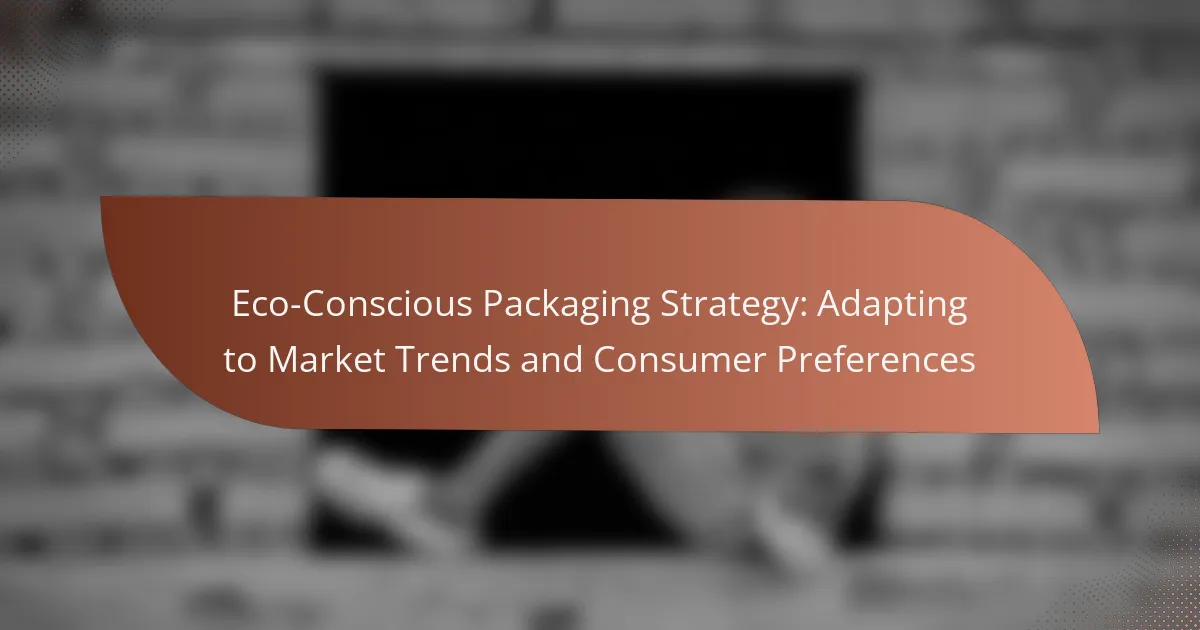As consumer awareness of environmental issues grows, e-commerce brands are increasingly adopting eco-conscious packaging strategies to align with market trends and preferences. By utilizing sustainable materials and fostering partnerships with eco-friendly suppliers, companies can enhance their brand reputation while meeting the demand for responsible practices. This shift not only improves brand image but also contributes positively to the planet, positioning businesses favorably in a competitive landscape.
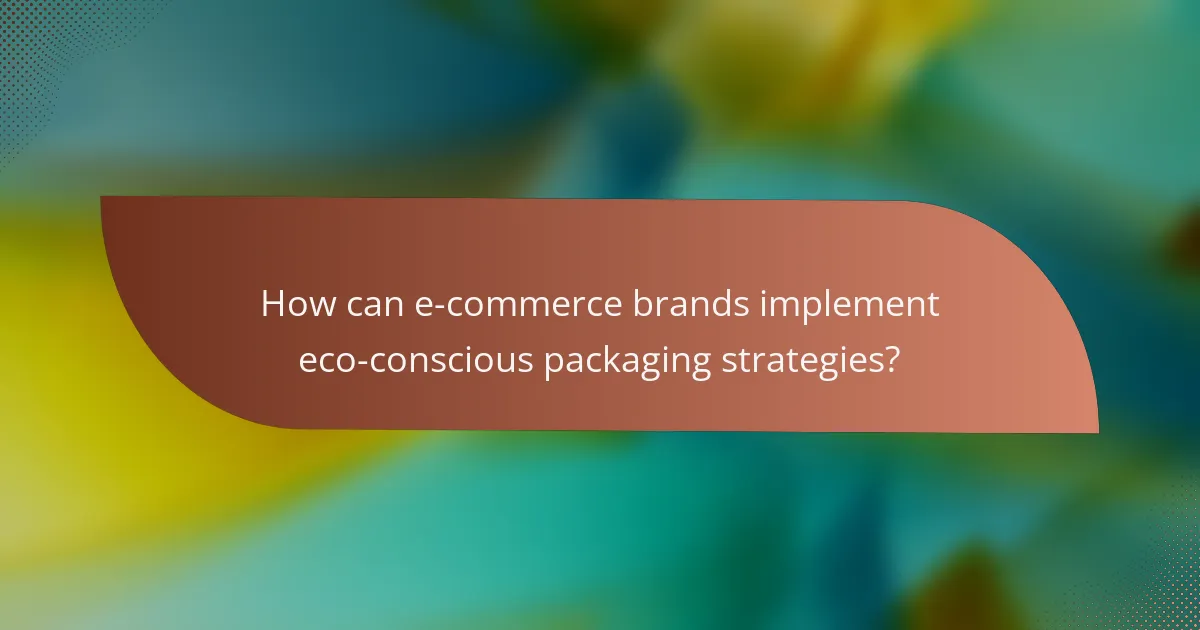
How can e-commerce brands implement eco-conscious packaging strategies?
E-commerce brands can implement eco-conscious packaging strategies by focusing on sustainable materials, design simplicity, and partnerships with eco-friendly suppliers. These approaches not only meet consumer demand for environmentally responsible practices but also enhance brand reputation.
Use biodegradable materials
Biodegradable materials break down naturally over time, reducing landfill waste. Options include plant-based plastics, paper, and compostable materials that can decompose within a few months under the right conditions.
When selecting biodegradable options, consider certifications like ASTM D6400 or EN 13432, which ensure materials meet specific environmental standards. Brands should also educate consumers on proper disposal methods to maximize the benefits of these materials.
Adopt minimalistic designs
Minimalistic packaging reduces material usage and waste while maintaining product protection. This approach often involves simpler shapes and fewer layers, which can significantly cut down on the overall packaging footprint.
For example, using flat-pack designs can save space during shipping and storage, leading to lower transportation costs and emissions. Brands should aim for designs that are both functional and aesthetically pleasing to attract eco-conscious consumers.
Incorporate reusable packaging
Reusable packaging encourages customers to return containers for future use, significantly reducing waste. Options include durable boxes, bags, or containers that can be utilized multiple times, creating a circular economy.
Implementing a return program can incentivize customers to participate, such as offering discounts or loyalty points for returning packaging. Clear communication about the benefits of reusability can enhance customer engagement and brand loyalty.
Partner with sustainable suppliers
Collaborating with suppliers who prioritize sustainability ensures that all aspects of the supply chain align with eco-conscious values. This includes sourcing materials that are ethically produced and environmentally friendly.
Brands should evaluate potential suppliers based on their sustainability practices, certifications, and transparency. Building strong relationships with these suppliers can lead to innovative solutions and shared goals in reducing environmental impact.
Utilize recyclable materials
Recyclable materials can be processed and reused, significantly decreasing the need for new raw materials. Common recyclable options include cardboard, paper, and certain plastics marked with recycling symbols.
To enhance recycling rates, brands should clearly label packaging with recycling instructions and ensure that materials are easy to separate. Engaging consumers through educational campaigns can further promote responsible disposal habits.
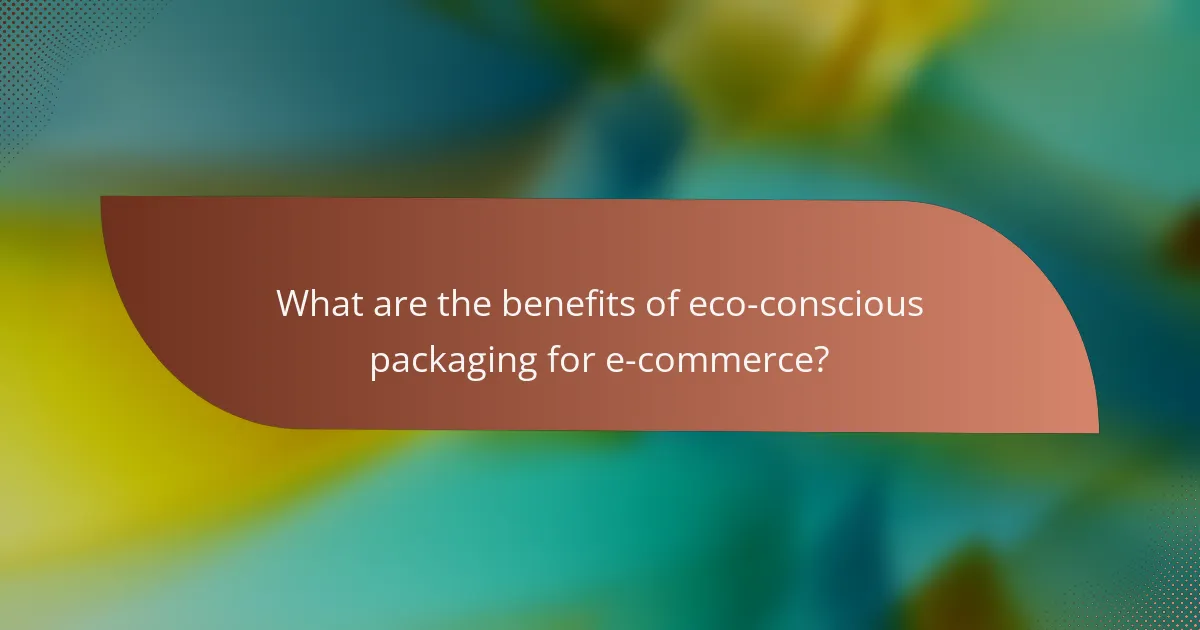
What are the benefits of eco-conscious packaging for e-commerce?
Eco-conscious packaging offers several advantages for e-commerce businesses, including improved brand image, reduced environmental harm, and alignment with consumer preferences. By adopting sustainable packaging practices, companies can enhance their market position while contributing positively to the planet.
Enhances brand reputation
Using eco-conscious packaging can significantly enhance a brand’s reputation. Consumers are increasingly drawn to companies that demonstrate environmental responsibility, which can lead to greater customer loyalty and trust. Brands that prioritize sustainability often stand out in a crowded market, attracting eco-minded shoppers.
For example, a company that uses biodegradable materials for shipping may be perceived as more ethical compared to competitors using traditional plastic. This positive perception can translate into increased sales and customer retention.
Reduces environmental impact
Eco-conscious packaging plays a crucial role in minimizing environmental impact. By opting for materials that are recyclable, compostable, or made from renewable resources, businesses can significantly reduce waste and pollution. This shift not only benefits the planet but also helps companies comply with growing environmental regulations.
For instance, switching from plastic to paper or plant-based packaging can lower carbon footprints and decrease landfill contributions. Brands can also implement practices like reducing packaging size to further lessen their environmental footprint.
Meets consumer demand for sustainability
Today’s consumers increasingly prioritize sustainability in their purchasing decisions. Eco-conscious packaging meets this demand, appealing to a demographic that values environmental stewardship. Brands that adopt sustainable practices are more likely to attract and retain customers who are willing to pay a premium for eco-friendly products.
Surveys indicate that a significant portion of consumers prefer brands that demonstrate a commitment to sustainability. By showcasing eco-friendly packaging, businesses can effectively communicate their values and align with consumer expectations.
Potential cost savings in materials
While the initial investment in eco-conscious packaging may seem higher, there are potential long-term cost savings. Many sustainable materials can be sourced at competitive prices, and reducing packaging size can lower shipping costs. Additionally, companies may benefit from tax incentives or grants aimed at promoting sustainable practices.
For example, using lightweight materials can decrease shipping expenses, while bulk purchasing of sustainable packaging can lead to lower per-unit costs. Businesses should evaluate their packaging strategies to identify opportunities for cost efficiency without compromising sustainability.
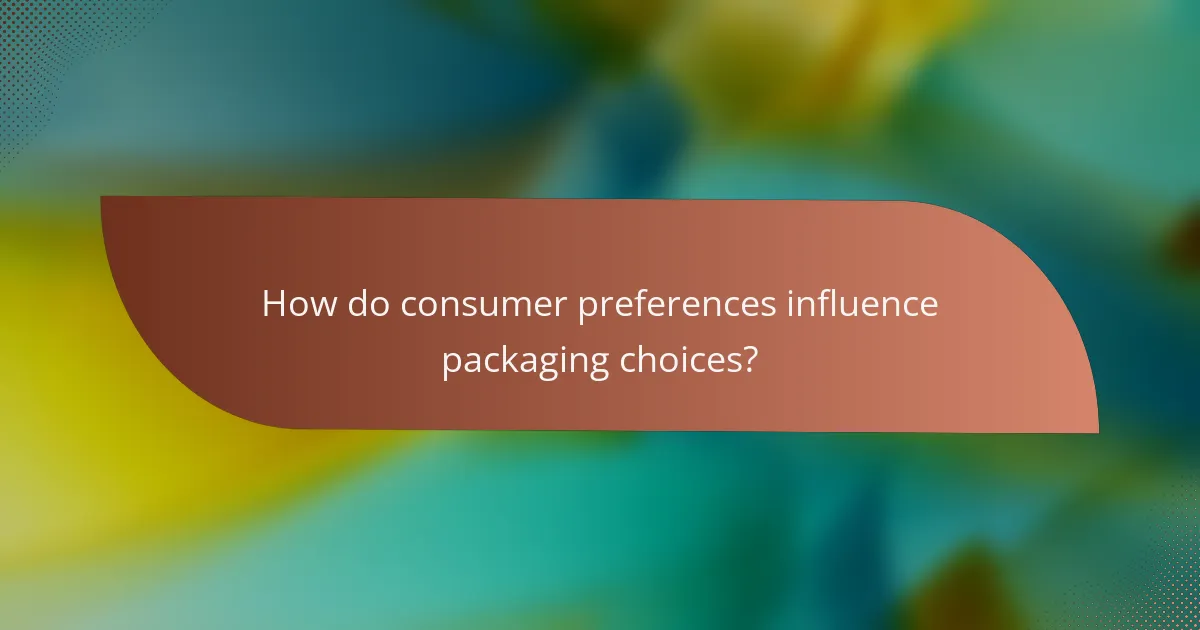
How do consumer preferences influence packaging choices?
Consumer preferences significantly shape packaging choices by driving demand for sustainable materials, transparency in sourcing, and awareness through social media. Companies must adapt their packaging strategies to align with these evolving consumer values to remain competitive.
Growing demand for sustainable options
The shift towards eco-friendly packaging is evident as consumers increasingly seek sustainable options. Many prefer materials that are biodegradable, recyclable, or made from renewable resources, reflecting a broader commitment to environmental responsibility.
For instance, brands that utilize plant-based plastics or recycled paper often see a positive response from consumers. Offering packaging that minimizes waste can enhance brand loyalty and attract environmentally conscious buyers.
Preference for transparency in sourcing
Consumers today value transparency regarding the origins of packaging materials. They are more likely to support brands that openly share information about their sourcing practices and the environmental impact of their packaging.
Brands can build trust by providing clear labeling and details about the sustainability of their materials. This transparency not only meets consumer expectations but also differentiates products in a crowded market.
Impact of social media on consumer awareness
Social media plays a crucial role in shaping consumer awareness about packaging choices. Platforms like Instagram and Twitter amplify discussions around sustainability, influencing purchasing decisions and brand perceptions.
Brands that engage with consumers on these platforms by sharing their sustainability efforts and packaging innovations can enhance their visibility and appeal. User-generated content showcasing eco-friendly packaging can further drive awareness and encourage others to make informed choices.
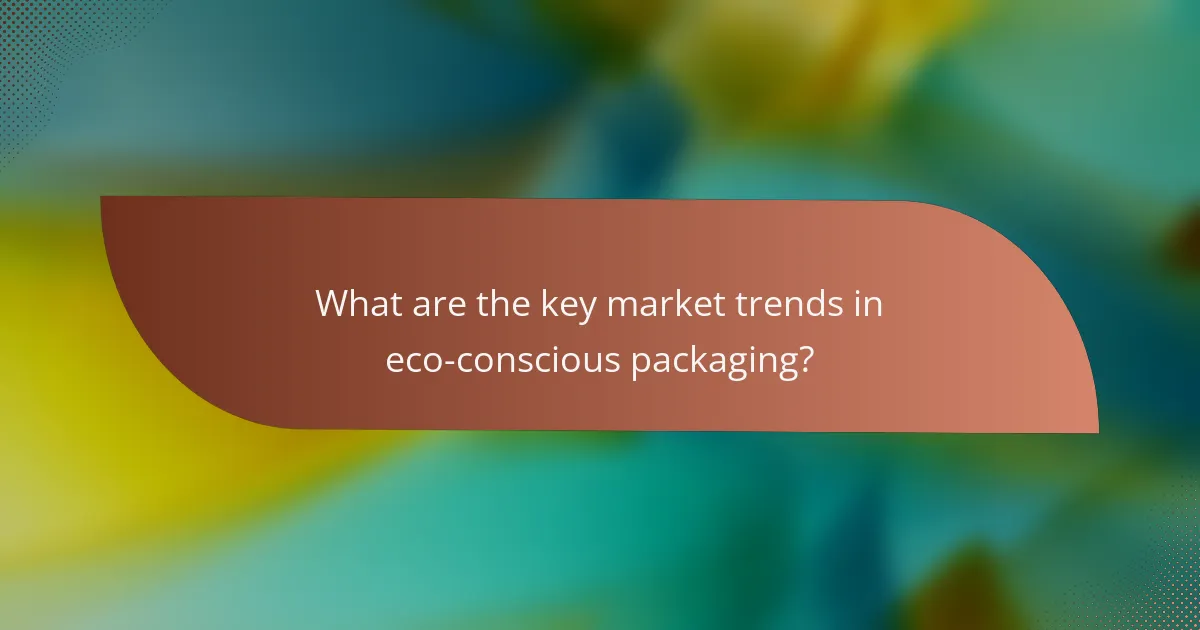
What are the key market trends in eco-conscious packaging?
Key market trends in eco-conscious packaging include a growing preference for sustainable materials, the adoption of circular economy principles, and advancements in smart packaging technologies. These trends reflect consumer demand for environmentally friendly options and the need for businesses to adapt to changing market dynamics.
Increase in plant-based materials
The use of plant-based materials in packaging is on the rise as companies seek to reduce their carbon footprint. Materials such as bioplastics, made from renewable resources like corn or sugarcane, are becoming popular alternatives to traditional plastics. This shift not only appeals to eco-conscious consumers but also aligns with regulatory pressures to minimize fossil fuel dependency.
Brands are increasingly incorporating plant-based options into their packaging lines, with many reporting that these materials can be just as effective as conventional options. For example, packaging made from PLA (polylactic acid) can be used for a variety of products, from food containers to cosmetic packaging.
Shift towards circular economy models
The circular economy model emphasizes reusability, recycling, and waste reduction, which is gaining traction in the packaging industry. Companies are redesigning their packaging to be more sustainable, focusing on materials that can be easily recycled or repurposed. This approach not only reduces waste but also conserves resources, making it a win-win for both businesses and the environment.
To implement circular economy practices, brands should consider using mono-materials that simplify recycling processes and encourage consumers to return packaging for reuse. Examples include refillable containers and packaging that can be returned to the manufacturer for recycling, which is becoming increasingly popular in markets across Europe and North America.
Rise of smart packaging technologies
Smart packaging technologies are emerging as a significant trend in eco-conscious packaging, offering enhanced functionality while promoting sustainability. These innovations include features like QR codes for recycling information, temperature indicators, and freshness sensors, which help consumers make informed decisions about product use and disposal.
Investing in smart packaging can improve customer engagement and reduce waste by ensuring products are used within their optimal timeframe. Companies should explore partnerships with tech firms to integrate these technologies effectively, ensuring that they align with sustainability goals while enhancing the consumer experience.

What criteria should brands consider when selecting eco-friendly packaging?
Brands should focus on material sustainability, recyclability, and the overall environmental impact when choosing eco-friendly packaging. Evaluating these criteria helps ensure that packaging aligns with consumer preferences for sustainability while minimizing ecological footprints.
Material sustainability
Material sustainability refers to the use of renewable, biodegradable, or recycled materials in packaging. Brands should prioritize materials that have a lower environmental impact throughout their lifecycle, from production to disposal. Common sustainable options include paper, glass, and certain bioplastics.
When selecting materials, consider their source and production methods. For instance, packaging made from post-consumer recycled content reduces the need for virgin materials and supports recycling systems. Additionally, brands should look for certifications like FSC (Forest Stewardship Council) for paper products to ensure responsible sourcing.
It’s essential to balance sustainability with functionality. For example, while biodegradable materials are eco-friendly, they may not always provide the same durability as traditional plastics. Brands should test materials to ensure they meet performance standards while still being environmentally responsible.
